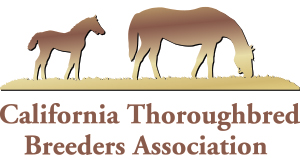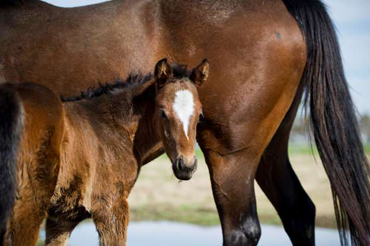By Sacramento Bee
SACRAMENTO, Calif. (Mar. 8, 2015) — On a thoroughbred ranch in Vacaville, a 3-week-old foal gallops close to its mother. Their bond seems natural, but it didn’t start out that way.
When the foal was born, it completely ignored its mother and refused to nurse.
University of California, Davis veterinary specialist John Madigan intervened moments after the birth with a novel treatment he calls “the squeeze.” It’s attracting attention from researchers studying autism in children, who see a possible parallel between Madigan’s work with horses and a similar technique — called kangaroo care — that’s often used on pre-term infants.
“The phenomenon that Madigan has observed in foals is interesting and dramatic,” said David Stevenson, professor of pediatrics at Stanford University.
Over the past five years, a dozen foals at Victory Rose Thoroughbreds in Vacaville have been born with neonatal maladjustment syndrome, or NMS, in which they are emotionally detached from their mothers. In each case, horse farm owner Ellen Jackson called Madigan, a UCD veterinary professor and specialist in equine and comparative neurology.
First identified in the 1950s, neonatal maladjustment syndrome affects roughly 5 percent of newborn horses.
“When these horses are born, they will walk to a corner and just stand there,” said Jackson, who has owned her farm for 25 years.
To counteract the condition, Madigan ties a soft rope harness around the foal’s body and gently squeezes it to increase pressure. The squeeze causes the foal to drop over and go to sleep.
After several minutes, the pressure is released and the foal awakens. Madigan said that in all cases where he has intervened with a foal with NMS, the foal has shed its detached behavior and run to its mother to interact and feed.
“We’ve had a dramatic improvement in 12 foals,” he said.
The squeeze technique is part of body of research that Madigan and others at UC Davis are pursuing to see if there’s a connection between high levels of neurosteroids in the blood and the later development of autism. Madigan said the foals born with NMS he has studied had high levels of neurosteroids in their blood, whereas foals that readily interacted with their mothers had normal neurosteroid levels.
Neurosteroids are brain steroids that can cross the blood-brain barrier and dampen the central nervous system. Further study into their effect at certain birth stages may offer a clue as to why some infants later develop detached behavior or symptoms associated with Autism Spectral Disorder, or ASD, said Madigan.
“The behavioral abnormalities in these foals seem to resemble some of the symptoms in children with autism,” Madigan said.
Madigan said he believes that neurosteroids are a crucial factor in a horse making a successful transition from birth to consciousness. He was the lead researcher on a 2011 study in which healthy foals given neurosteroids began displaying a lack of affinity for their mothers and a decreased response to stimuli.
High neurosteroid levels in the womb protect the mother by keeping babies asleep and lessening physical activity — like galloping — that could hurt her.
The UC Davis research may offer a valuable clue to what may lead to the development of autism in human infants — particularly pre-term infants and cesarean birth babies, and those that spend a very short time in the birth canal.
Madigan said he believes that if a foal passes too rapidly through the birth canal or is delivered via cesarean section, it loses the pressure on its body that signals the body to drop neurosteroid levels. He sees a potential parallel in human infants. Three studies conducted in the past two years suggest that pre-term babies are at higher risk for developing autism.
One Finnish study, published in the Journal of Pediatrics in 2012, found that babies weighing less than 3 pounds were three times as likely to develop ASD compared to normal-weight babies.
As in horses, neurosteroids are also emerging as a potential culprit in human autism. A 2013 study by Polish scientists found that autistic children tested at ages 3 and 9 had significantly higher salivary concentrations of a group of steroid hormones than control children.
The success of Madigan’s squeeze technique has prompted him and other researchers to begin studying whether kangaroo care, a common treatment to improve the health of premature infants, could also help prevent disorders on the autism spectrum. Pioneered in Bogota, Colombia, in the late 1970s, kangaroo care has become a widely used treatment for pre-term babies in neonatal units in the United States. A parent or caregiver places a mostly naked baby on their chest, skin to skin, and holds them there, sometimes for hours. The baby is secured to the caregiver with a stretchy cloth band.
Stanford University’s Stevenson has joined Madigan in applying to the Bill and Melinda Gates Foundation for a $100,000 grant to fund combined veterinary and human research on kangaroo care and neurosteroids. The question is whether infants who receive kangaroo care will experience a drop in steroid levels.
If they get the money from the Gates foundation, Stevenson and Madigan plan to study neurosteroid levels in the blood and saliva of 42 pre-term infants — some of whom get kangaroo care and some of whom don’t.
“The plan is to apply for a much bigger grant to expand the study to obtain greater understanding, including neurosteroid risk factors associated with preterm birth,” Stevenson said.
Two different studies will soon be underway at UC Davis to establish whether elevated levels of neurosteroids, during and after birth, may be a factor in the eventual development of ASD.
In one of the studies, scheduled for completion this fall, doctors at UC Davis will take blood samples from six pre-term babies in intensive care and six babies from the newborn nursery, said Mark Underwood, chief of neonatology at UC Davis Children’s hospital. The blood samples will then be checked for neurosteroid levels. In another study, an existing database of 1,800 children will be used to help establish whether neurosteroids are a factor in the development of ASD.
While establishing a definitive link between neurosteroids and autism will require more research, Madigan says, his squeeze technique is already producing results for Jackson, the horse ranch owner. It has saved her from paying for the hundreds of hours of round-the-clock care —including bottle feeding — required for foals with maladjustment syndrome.
“Almost all of the foals that we have squeezed wake up out of that, and they’re almost normal,” Jackson said.


